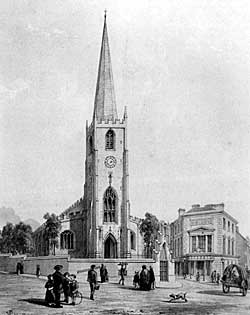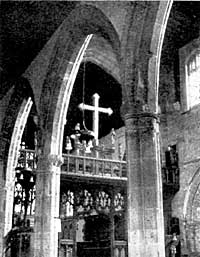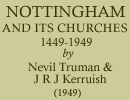SS. Peter and Paul

St Peter's church, c.1860.
SS. Peter and Paul—to give it its full ancient title—is an older building than the Mother Church though it has been so heavily restored that it might almost be considered modern. The very dark chancel is Victorian, but there is an excellent rood screen properly furnished with the figures of St. Mary and St. John, though, most curiously, the central figure of Our Lord is absent and thus the effect is one of incompleteness. F. E. Howard's statue of St. George is one of the great treasures of art in Nottingham. Liable to be missed bv the visitor is the picture by Walter Hilton, now forming the ceiling of the west entrance. There are two or three distinguished tablets on the north wall by Sir George Frampton and Albert Toft. A good piece of Georgian carpentry can be seen in the frontal of inlaid mahogany in the south chapel altar, once part of a pulpit. The two arcades differ from each other and are interesting examples of thirteenth- and fourteenth-century work, as is also the oak roof of the north transept. The lofty spire was once crocketted and this must have added to its grace.
The building has been much knocked about by insertion of pews and galleries, and the stone used for the outer walls in the eighteenth century was ill chosen and weathered so badly that the outer walls are now almost new creations. The iron stays for holding the maces at state visits of mayor and corporation can be seen on a pier of the north arcade. The organ, built by Green in 1770 for York Minster, is in an eighteenth-century case worthy of a place where it could be better admired. Of the same date is the church plate of massive old silver. There is a good ring of ten bells whose notes can be heard over a wide area. Number seven was given by Margery Doubleday to call her fellow washerwomen to their work every day at 4 a.m.
The Archdeacon of Nottingham used to hold his court at the west end of the south aisle, and the mahogany pulpit, now the Lady Altar, suffered yet another transformation bv being adapted as a kind of official desk for the court. The Guild Book preserved in the vestry is the oldest church document in the city. It dates from about 1440. At that time there were five chapels in the church—Our Lady and St. Andrew in the south aisle, St. George and Holy Cross in the north aisle, and All Saints, probably in a crypt below the eastern bay of the north aisle, where later the Smith family vault was made.
The roofs of both nave and south aisle are Perpendicular, and though restored have not been altered from their original design.

The interior of St Peter's church.
The reredos, in a cold white stone, is modern in its sculpture. It is placed within an inharmonious pseudo-Gothic frame of clumsy crockets and the whole scale is far too large for its site. A more suitable place and a plainer frame might be found for it.
The glass in the nave is not unworthy—a good deal of it is by Clayton and Bell and contains small scripture scenes in the nineteenth-century version of fifteenth-century glass. The west window in the tower is a good example of Pre-Raphaelite tendencies. Repairs in the eighteenth century resulted in the substitution of the original clerestory lights by round-headed windows, but these have been removed in recent years in favour of a range of fifteenth-century-style larger windows, to the great improvement of the fabric and the lighting. The maintenance of this ancient church has been a heavy burden for the last half century, but with last year's completion of the north aisle it is believed that no more major operations should be required for some time.
The stairs to the Rood loft exist and still lead to the top of the screen as of old. At their head there is an altar stone built into the wall. Its five incised crosses prove it to be one of the former altar stones, though whether of the main altar or of one of the chapels is unknown.
Of the founder little is known except that between 1103 and 1108 William Peveril granted to Lenton Priory the church of St. Mary and also the churches of St. Peter and St. Nicholas, with lands, tithes and appurtenances. To-day its problem is that of a city church from which the resident population has gone, leaving only shops, offices and warehouses. Yet it still fulfills a useful purpose with good congregations coming from far afield, and a certain number of central services are held here, notably Advent and Lent lectures, and a choral eucharist sung by the boys of the Bluecoat School on saints' days at eleven—a convenience for many people who find themselves in town on these occasions. The School worships here on Sundays.
